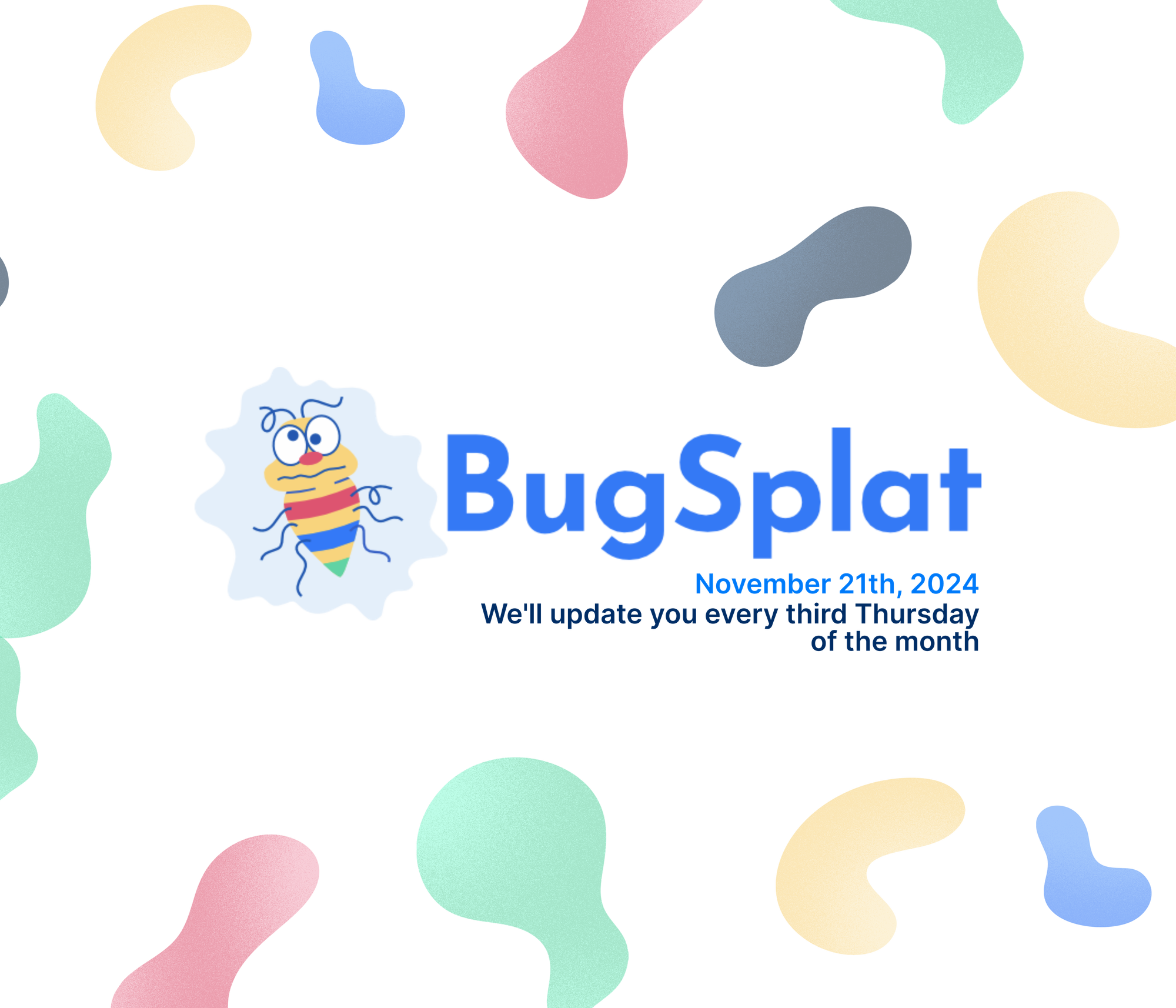

Jira Issue Syncing | BugSplat's November Newsletter

Joey P
Head of Product at BugSplat
In this newsletter:
- Bi-Directional Jira Syncing: Keep your BugSplat defect groups and Jira issues perfectly aligned.
- What’s Next?: Help us decide which issue tracker to add sync to next—and enter to win a mechanical keyboard!
- Crash Status Updates: Manage defects with new Open, Closed, and Regression statuses.
Hey BugSplatters,
Joey here.
At BugSplat, we’re proud to be a bootstrapped company—to us that means our only bosses are you, our users.
When you share a feature request, report an issue, or suggest improvements, we listen. Our focus is always on aligning with your needs—not chasing outside goals set by business folks.
This setup lets us move quickly to turn your feedback into reality. Whether it’s fixing a reported issue or rolling out requested features, we take pride in building and supporting a product that works for you.
Your feedback shapes everything we do—from the Trello cards on our to-do list to the goals we set for ourselves. Keep it coming—we’re all ears (or eyeballs, depending on the medium).
Speaking of which, this month we shipped some exciting new features inspired by user feedback—and we think you’ll love them! Below, we’ll walk you through what’s new, ask for your input to help us decide what to tackle next, and give you a chance to get a mechanical keyboard!
We’re looking forward to hearing from you—especially on our new Discord server, which you should check out if you haven’t already.
Bi-Directional Jira Syncing
Keeping your BugSplat crash groups and Jira issues in sync just got a whole lot easier! With bi-directional status syncing, you can ensure both systems stay perfectly aligned, saving time and avoiding headaches.
Here’s how it works:
- When a Jira issue is updated, BugSplat can automatically update the status of the linked defect group.
- Similarly, when you update the status of a defect group in BugSplat, it pushes the update to Jira.
The result? Seamless synchronization between the two platforms, so you can spend less time double-checking statuses and more time squashing bugs.

This feature is all about making your life easier. By keeping BugSplat and Jira in sync, you’ll eliminate manual updates, reduce errors, and streamline your workflow. It’s like having a personal assistant for your defect tracking!
Read more in our docs --> https://docs.bugsplat.com/introduction/development/integrating-with-tools/issue-trackers/jira#bi-directional-status-syncing
What's Next?
If you’re not using Jira, we’d love to hear which issue tracker you’d like us to add this feature to next. Here are some of the options we’re considering:
- Azure DevOps
- ClickUp
- Favro
- GitHub
- GitLab
- Monday.com
- YouTrack
- Other
If you select "Other," please reply to this message and let us know which issue tracker your team uses!
To register your vote (and enter for a chance to win a mechanical keyboard in our giveaway!), click here --> https://form.typeform.com/to/BwnC63s4
Note: there is an option to select that your team uses Jira, so our Jira users are still able to enter for the giveaway without corrupting the data.

Crash Status: Open, Closed, Regression
As we mentioned earlier, the launch of bi-directional syncing introduces a new paradigm in BugSplat: the ability to delineate a crash group as Open, Closed, or mark it as a Regression—indicating that it’s tied to a bug that was fixed in a previous version.
We’re incredibly excited about this feature and the possibilities it unlocks for better crash management. Over the coming weeks, we’ll be rolling out more updates in this area to further enhance how you track and resolve defects.
If you’ve had a chance to use this feature, we’d love to hear from you! Send your feedback directly to me at joey@bugsplat.com. Your input is invaluable as we continue to refine and expand this exciting capability.
Stay tuned—there’s more to come!
Trivia Corner: Ada Lovelace
Which of the following innovations is credited to Ada Lovelace and is considered a cornerstone in the history of computer science?
A) The invention of the differential engine
B) The first algorithm designed for a machine
C) The creation of the assembly language
D) The development of electronic circuits
*Scroll to the bottom for the answer!
Wrapping Up 🍂
Well, look at you—you made it to the end! Since I’ve still got your attention, let’s recap what we covered:
- Bi-directional syncing with Jira and a call for votes on what platform we should tackle next (don’t forget, a mechanical keyboard might be yours!).
- BugSplat’s new crash status options—Open, Closed, and Regression—that are setting a new standard for crash management.
- A quick celebration of Ada Lovelace, the world’s first computer programmer.
Now it’s your turn—what’s on your mind? Got feedback? Ideas? Dinner recipes? I’m all ears. Drop me a note at joey@bugsplat.com. I just made this herbed white bean and sausage stew which was awesome as it's getting cold here in Colorado. Tip: don't forget the balsamic vinegar.
And if you’re looking for something fun to watch after all that bug squashing, let me recommend Taskmaster. It’s chaos, comedy, and creative problem-solving all rolled into one—perfect for unwinding.
Thanks for being part of what makes BugSplat awesome. We’ll see you in the next email, and hopefully on Discord!
Answer: B) The first algorithm designed for a machine
Ada Lovelace (1815–1852) was an English mathematician and writer widely regarded as the world's first computer programmer. She worked with Charles Babbage on his design for the Analytical Engine, an early mechanical general-purpose computer. Lovelace recognized that the machine could do much more than simple calculations—it had the potential to execute sequences of instructions to solve complex problems. She wrote the first algorithm intended to be processed by a machine, specifically for computing Bernoulli numbers. Her visionary insights laid the groundwork for modern computing. Fun fact: Ada is often celebrated as a pioneer who bridged the gap between theoretical mathematics and practical computation. In her honor, the programming language Ada was named after her.

Subscribe to our newsletter
Get the latest posts and updates delivered directly to your inbox.
